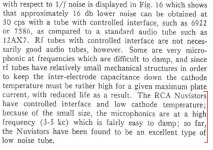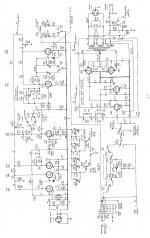I read it. I even learnt something: that cathode interface problems can be a source of 1/f noise. That may explain why some people prefer 'computer' versions of valves, as they have cathodes designed not to form an interface layer when the valve is left with heater on but no anode current.john curl said:(If they will read it) '-)
The reality of cathode interface is often denied by audio people; for some reason it seems to be rather better known by RF people even though it has greater effect at lower frequencies. Maybe RF people are just more technically aware?
Maybe if audio circuits were considered as RF design exercises they would perform better, subjectively ...Maybe RF people are just more technically aware?
I read it
That may explain why some people prefer 'computer' versions of valves, as they have cathodes designed not to form an interface layer when the valve is left with heater on but no anode current.
Still Nuvistors are held as no-no for riaa pre On what grounds? (and I have some of these waiting to be used ).
… to form an interface layer when the valve is left with heater on but no anode current.
Have you experienced this effect?
Is it severe?
I use the pactice heaters on, then HT on and for short periods of non use I turn off only the HT as I don’t think the thermal shock from heaters turning on is a good thing.
George
Attachments
Still Nuvistors are held as no-no for riaa pre On what grounds? (and I have some of these waiting to be used ).
Stunningly microphonic.
So, I read your answer as “beware of external vibrations”.
Well, what can I say? I would offend all and any diyer here
George
Is it worth it?
Well, what can I say? I would offend all and any diyer here
George
Not personally. However, it is common knowledge among users of valve communications receivers that rarely used but permanently heated valves, such as the crystal calibrator, often stop working due to interface. I suspect that an interface layer could raise noise levels long before it stopped a valve from oscillating - especially as at RF the parallel capacitance bypasses the layer and so reduces its effect.gpapag said:Have you experienced this effect?
Is it severe?
Please don't use nuvistors for audio. Their natural habitat is VHF receiver front-ends so that is where they should be left to live their lives. I'm not certain that even the Russians still make them so prices are creeping ever higher.
Not personally. However, it is common knowledge among users of valve communications receivers…
This seems that the effect is strong. Thank you.
Their natural habitat is VHF receiver front-ends so that is where they should be left to live their lives.
So that could be the case with fets too.
I'm not certain that even the Russians still make them so prices are creeping ever higher.
I am allowed to think only for bits I have in my junk carton boxes. Besides, they were made in USA
George
Stunningly microphonic.
"They were used normally in high frequency or very wide band applications (e.g. radio, tv, Tektronics oscilloscopes), but also in some very specific audio systems. And in spite of their scarce notoriety, they were used by major companies: for example Conrad Johnson (Premier 6 and Premier 7 pre-amplifiers, where nuvistors were used in the head pre-amp), McIntosh (MR65, MR71 tuners, in RF stages), Harman Kardon (Citation VII tuner again in RF stages) and also AKG (C-12A microphone, as pre-amp) and Neumann (U47 microphone, again as preamp in some variants: in facts the small size suggested to use them also as internal pre-amplifiers in these famous microphones)."
Dan.
"They were used normally in high frequency or very wide band applications (e.g. radio, tv, Tektronics oscilloscopes), but also in some very specific audio systems. And in spite of their scarce notoriety, they were used by major companies: for example Conrad Johnson (Premier 6 and Premier 7 pre-amplifiers, where nuvistors were used in the head pre-amp), McIntosh (MR65, MR71 tuners, in RF stages), Harman Kardon (Citation VII tuner again in RF stages) and also AKG (C-12A microphone, as pre-amp) and Neumann (U47 microphone, again as preamp in some variants: in facts the small size suggested to use them also as internal pre-amplifiers in these famous microphones)."You could take heroic steps to isolate from vibration and acoustic impingement. Is it worth it?
Dan.
And they are (were?) used in high-temperature applications like oil well drilling heads. The sporadic demand for them among audio folk led some companies to carefully screen the would-be buyers, who were otherwise depleting the replacement stock! Was Conrad-Johnson using them? I know that Musical Fidelity was, and were scooping up as many as they could, and then transitioned to "trivistors" iirc, whatever those are.Not personally. However, it is common knowledge among users of valve communications receivers that rarely used but permanently heated valves, such as the crystal calibrator, often stop working due to interface. I suspect that an interface layer could raise noise levels long before it stopped a valve from oscillating - especially as at RF the parallel capacitance bypasses the layer and so reduces its effect.
Please don't use nuvistors for audio. Their natural habitat is VHF receiver front-ends so that is where they should be left to live their lives. I'm not certain that even the Russians still make them so prices are creeping ever higher.
Yes Skov, which I hadn't seen, thanks for that! is good for his day. It looks as if he relies heavily on the good Bell book, and it's a bit odd that he doesn't mention the van der Ziel "Noise" which had been out for quite a while by then. The remarks on FETs are necessarily terse as they were so new at that time and rapidly improving, and until the landmark van der Ziel paper of 1962 even the very nature of the noise mechanisms was controversial (should really say just wrong!). And the 1962 paper was not absorbed by many for some time thereafter --- it tripped me up for a while because I trusted some astronomers at Princeton
I also like Skov's managing to get "cooled" terminations in there, in such a relatively short paper.
EDIT: Ah this just crossed the wire a moment after Max Headroom's... Thanks for the corroboration and augmentations.
Last edited:
The "trivistor" tube -- four of 'em are used in the Tri-Vista's output stage -- is actually a 5703WB subminiature heater-cathode triode (Musical Fidelity dubbed it the trivistor so that "Tri-Vista" would echo the nuvistor's "Nu-Vista" designation). It was developed in the late 1950s by Raytheon as a tube with unusual resistance to mechanical vibration, impact, and temperature extremes. It was designed to offer long life -- MF estimates at least 100,000 hours, but points out there hasn't ever been a reported tube failure during the design cycle and product life of any of the Tri-Vista components yet.
PS I did do some testing of nuvistors recently, after discovering a box of 6DS4s in the residue of parts from a failed business, and after buying some expensive sockets for them, found them rather less-than-ideal triodes in terms of constant mu. So I was a bit disappointed, even though it would be ludicrous to design with them today.
Cute little buggers though.
Cute little buggers though.
and Neumann (U47 microphone, again as preamp in some variants: in facts the small size suggested to use them also as internal pre-amplifiers in these famous microphones)
yep, you HAVE seen the heroic efforts taken for the U47 standmount/guard havent you?

"The "trivistor" tube -- four of 'em are used in the Tri-Vista's output stage -- is actually a 5703WB subminiature heater-cathode triode (Musical Fidelity dubbed it the trivistor so that "Tri-Vista" would echo the nuvistor's "Nu-Vista" designation). It was developed in the late 1950s by Raytheon as a tube with unusual resistance to mechanical vibration, impact, and temperature extremes. It was designed to offer long life -- MF estimates at least 100,000 hours, but points out there hasn't ever been a reported tube failure during the design cycle and product life of any of the Tri-Vista components yet." Thanks Frank.
And this discussion shouldn't be without mention of the nearly last hurrah for extracting bandwidth from triodes, the Western Electric one for mounting in waveguides with an insanely small grid-cathode spacing, the 416. The discussion of it introduced me to the term inselbildung
Wavebourne also mentioned another bizarre tube a while ago with quite peculiar characteristics. Which reminds me that we haven't seen him lately.
And this discussion shouldn't be without mention of the nearly last hurrah for extracting bandwidth from triodes, the Western Electric one for mounting in waveguides with an insanely small grid-cathode spacing, the 416. The discussion of it introduced me to the term inselbildung
Wavebourne also mentioned another bizarre tube a while ago with quite peculiar characteristics. Which reminds me that we haven't seen him lately.
It's funny to read all these comments on Nuvistors, knowing that the actual tape recorder was manufactured and very good music was recorded on such machines. Some of your favourite LPs/CDs/SACDs might even contain material that has gone thru MR-70 electronics at some stage. Vanguard, Everest, Audioquest, Acoustic Sounds, Stereophile .. 
Several complete MR-70s and even more MR-70 electronics are still in use to this day, as far as I know.
Sonicraft A2DX Lab: Ultimate Multitrack Analog to Digital Transfers > MR70
Studio A
Here's the PB part of the electronics:
Several complete MR-70s and even more MR-70 electronics are still in use to this day, as far as I know.
Sonicraft A2DX Lab: Ultimate Multitrack Analog to Digital Transfers > MR70
Studio A
Here's the PB part of the electronics:
Attachments
- Status
- Not open for further replies.
- Home
- Member Areas
- The Lounge
- John Curl's Blowtorch preamplifier part II

